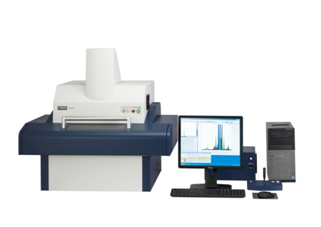 |
|||||
| Name: | Fluorescent X-ray Coating Thickness Gauge | ||||
| Type: | FT9500 Series | ||||
| Overviews: | Advanced x-ray microfocus technology has achieved high brilliance beam with an actual beam size of less than 0.1mm in diameter. Consequently, FT9500 Series is capable of measurements of micro spots and thin film applications, such as lead frames, connectors, and flexible PCBs, that are difficult to measure with conventional models due to in sufficient fluorescent X-ray intensity from measurement samples. | ||||
| Features: | 1. Ultra Thin Film and Multilayered Film Measurement Poly capillary, X-ray focusing optics system, enables micro beam size of less than 0.1mm in diameter with high intensity that is equivalent to 50 times that of conventional collimator models in Au plating measurement. As a result, FT9500 series has a capability of quantitative measurement of single nano meter of Au with high accuracy. Besides, it can simultaneously measure each coating thickness of layer sin multilayered applications, such as Au/Pd/Ni/Cu and Au/Ni/Ti/Si. 2.Mapping Mapped image with micro beam is effective for the distribution analysis of plating thickness and specific elements. 3. Hazardous Substance Analysis (for RoHS and ELV compliance) FT9500 provides the best solution for quantitative analysis of hazardous substances. High resolution semiconductor detector liquid nitrogen free is able to detect microelements. Examples are Pb in Pb-free solder and electoless Nickel that are typical component in Electric, Electronics, and Auto products. 4. Particle Analysis High intensity micro beam combined with high count rate detector makes possible of particle analysis. CCD camera can specify particles, and then subtraction spectrum display functions the qualitative analysis of the particles. 5. Data Editing Function MS-EXCEL® is equipped with statistical processing function that compiles measurement data as STDEV, Mean, Max, Min, CV, and Cpk. MS-WORD® provides detailed measurement reports with the sample image |
||||
|
Specifications
|
|||||
| Elements Measured: | Atomic Numbers 13(Al) to 83(Bi) | ||||
| X-Ray Tube: | Tube Voltage : 50kV, Current : 1mA | ||||
| Detector: | Semiconductor Detector (Liquid Nitrogen Free) | ||||
| X-Ray Focusing Optics System: | Capillary | ||||
| X-Ray Beam Size: | 0.1mm | ||||
| Sample Observation : | CCD Camera (With zoom) | ||||
| Focus : | Laser Pointer | ||||
| Filter : | Primary Filters | ||||
| X-Ray Station : | Desktop Personal Computer(OS:MS-Windows XP)® , 19&rdquoLCD Monitor | ||||
| Coating Thickness Software : | Film Analysis FP Method (Max 5 Layer Coating, 10 Elements) Calibration Curve Method (Single & Double Layer, Composition of Alloy Foils) |
||||
| Quantitative Analysis : | Bulk FP | ||||
| Options : | Mapping Software, Judgment Software for Hazardous Substance, Spectrum Matching Software, Image Processing | ||||
| Measurement Function : | Automatic Measurement, Canter Searching | ||||
| Data Processing : | MS-EXCEL®, MS-WORD® installed | ||||
| Report Safety : | Interlocking Sample Door, Sample Collision Prevention Mechanism (crash protection), Diagnostic Function | ||||
 |
|||||
| Name: | Fluorescent X-ray Coating Thickness Gauge | ||||
| Type: | FT9500 | ||||
| Overview: | Advanced x-ray microfocus technology has achieved high brilliance beam with an actual beam size of less than 0.1mm in diameter. Consequently, FT9500 Series is capable of measurements of micro spots and thin film applications, such as lead frames, connectors, and flexible PCBs, that are difficult to measure with conventional models due to in sufficient fluorescent X-ray intensity from measurement samples. | ||||
| Features: | 1. Ultra Thin Film and Multilayered Film Measurement Poly capillary, X-ray focusing optics system, enables micro beam size of less than 0.1mm in diameter with high intensity that is equivalent to 50 times that of conventional collimator models in Au plating measurement. As a result, SFT9500 series has a capability of quantitative measurement of single nano meter of Au with high accuracy. Besides, it can simultaneously measure each coating thickness of layer sin multilayered applications, such as Au/Pd/Ni/Cu and Au/Ni/Ti/Si.
2. Mapping Mapped image with micro beam is effective for the distribution analysis of plating thickness and specific elements. 3. Hazardous Substance Analysis (for RoHS and ELV compliance) SFT9500 provides the best solution for quantitative analysis of hazardous substances. High resolution semiconductor detector liquid nitrogen free is able to detect microelements. Examples are Pb in Pb-free solder and electoless Nickel that are typical component in Electric, Electronics, and Auto products. 4. Particle Analysis High intensity micro beam combined with high count rate detector makes possible of particle analysis. CCD camera can specify particles, and then subtraction spectrum display functions the qualitative analysis of the particles. 5. Data Editing Function MS-EXCELR is equipped with statistical processing function that compiles measurement data as STDEV, Mean, Max, Min, CV, and Cpk. MS-WORDR provides detailed measurement reports with the sample image. |
||||
|
Specifications
|
|||||
| Elements Measured: | Atomic Numbers 13(Al) to 83(Bi) | ||||
| X-Ray Tube: | Tube Voltage : 50kV, Current : 1mA | ||||
| Detector: | Semiconductor Detector (Liquid Nitrogen Free) | ||||
| X-Ray Focusing Optics System: | Capillary | ||||
| X-Ray Beam Size: | 0.1mmf | ||||
| Sample Observation : | CCD Camera (With zoom) | ||||
| Focus : | Laser Pointer | ||||
| Filter : | Primary Filters | ||||
| X-Ray Station : | Desktop Personal Computer(OS:MS-Windows XP)R , 19"LCD Monitor | ||||
| Coating Thickness Software : | Film Analysis FP Method (Max 5 Layer Coating, 10 Elements) Calibration Curve Method (Single & Double Layer, Composition of Alloy Foils) |
||||
| Quantitative Analysis : | Bulk FP | ||||
| Options : | Mapping Software, Judgment Software for Hazardous Substance, Spectrum Matching Software, Image Processing | ||||
| Measurement Function : | Automatic Measurement, Canter Searching | ||||
| Data Processing : | MS-EXCELR, MS-WORDR installed | ||||
| Report Safety : | Interlocking Sample Door, Sample Collision Prevention Mechanism (crash protection), Diagnostic Function | ||||
